七下 期末复习课件 Unit 1-Unit 12 语法复习(共67张PPT)
文档属性
| 名称 | 七下 期末复习课件 Unit 1-Unit 12 语法复习(共67张PPT) | 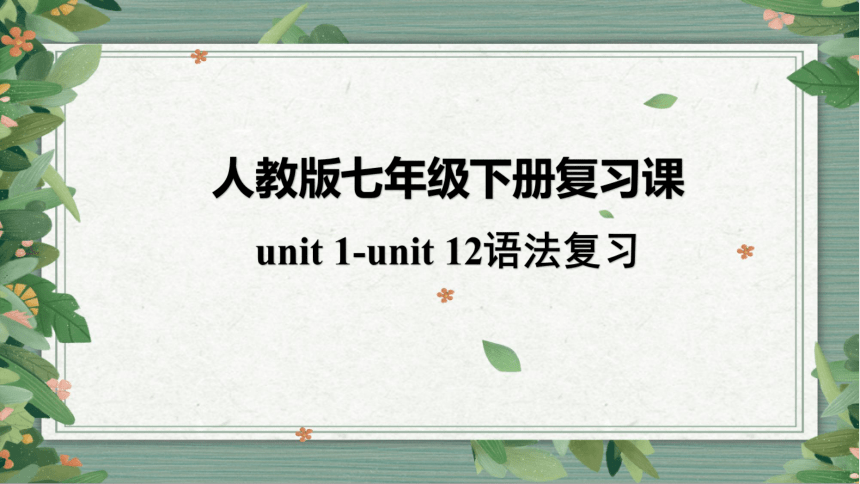 | |
| 格式 | pptx | ||
| 文件大小 | 47.2MB | ||
| 资源类型 | 教案 | ||
| 版本资源 | 人教新目标(Go for it)版 | ||
| 科目 | 英语 | ||
| 更新时间 | 2024-06-25 14:18:04 | ||
图片预览

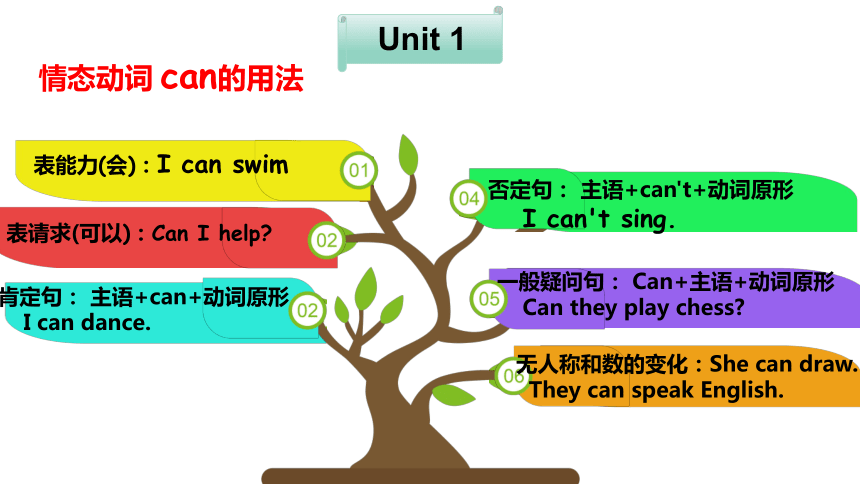
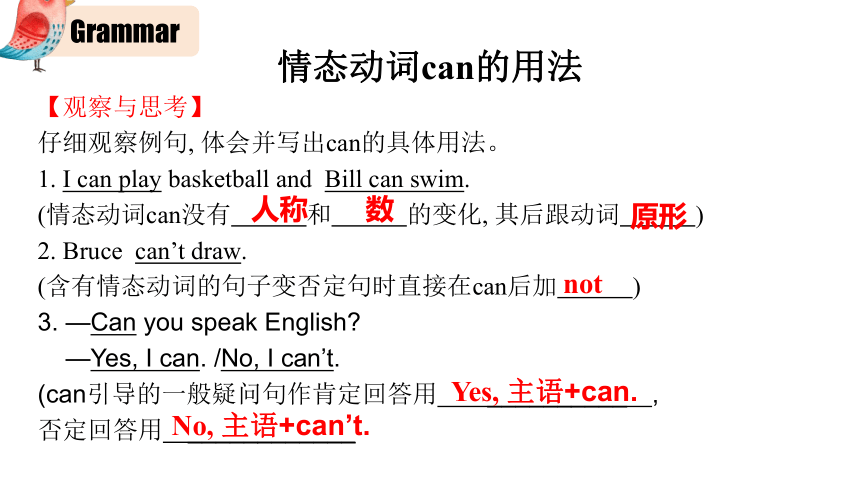
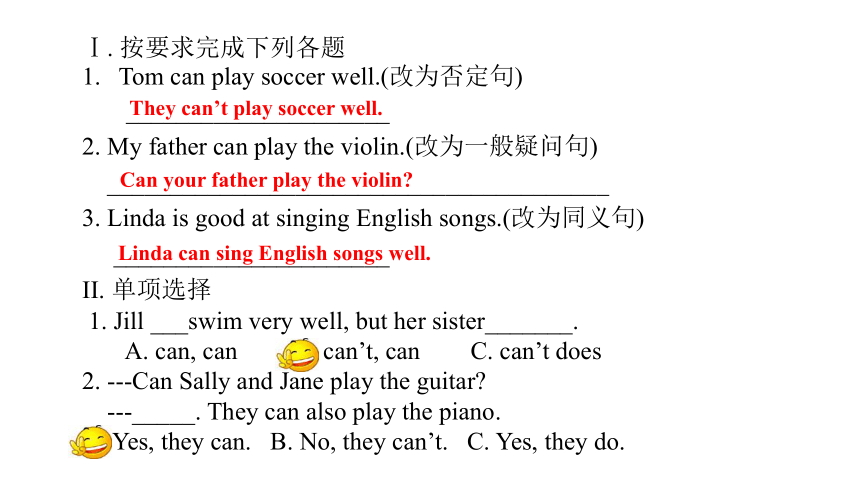
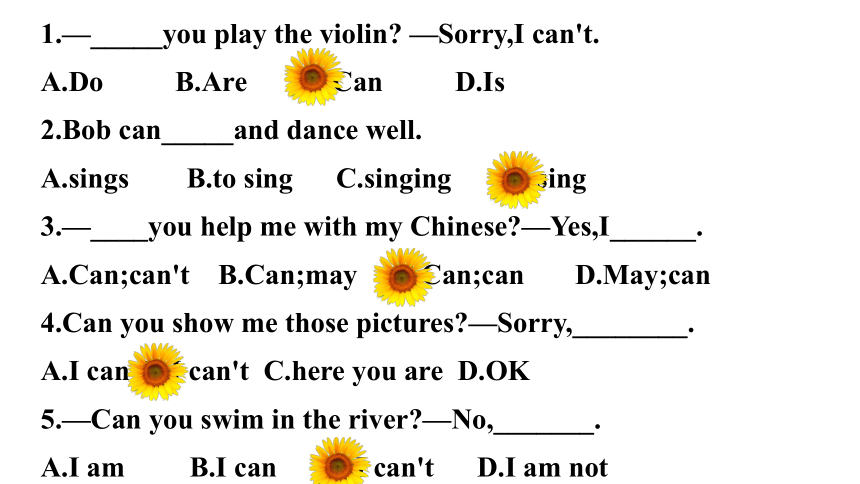
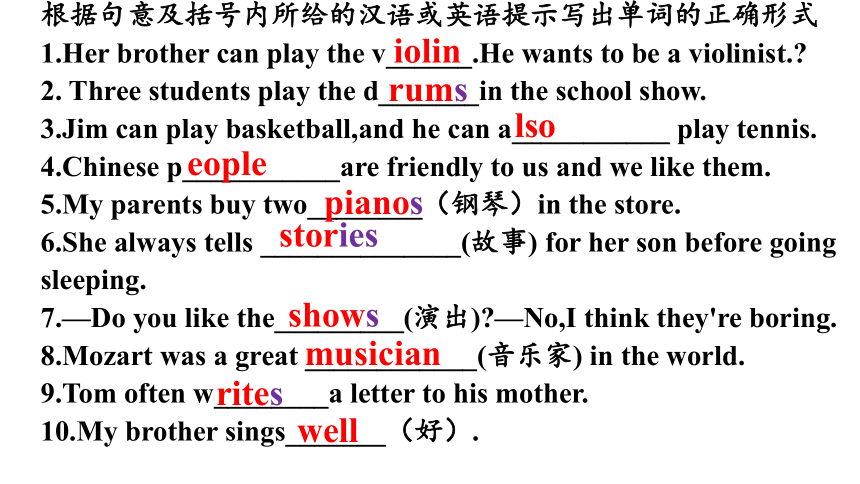
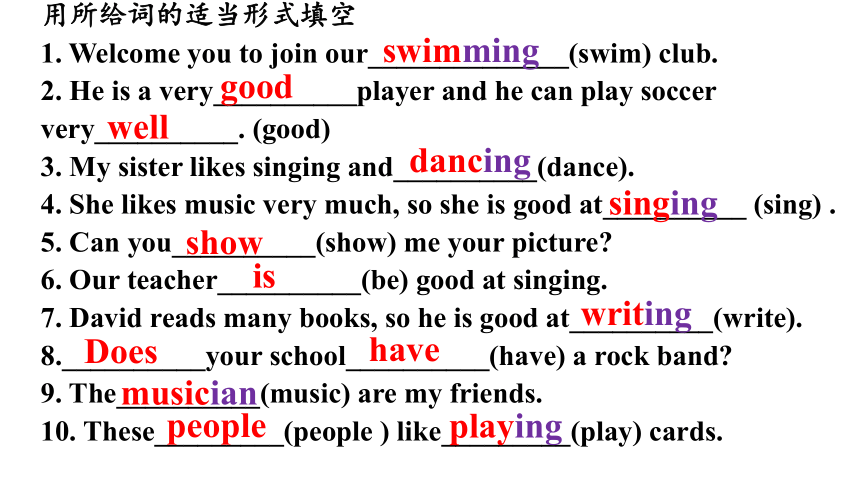
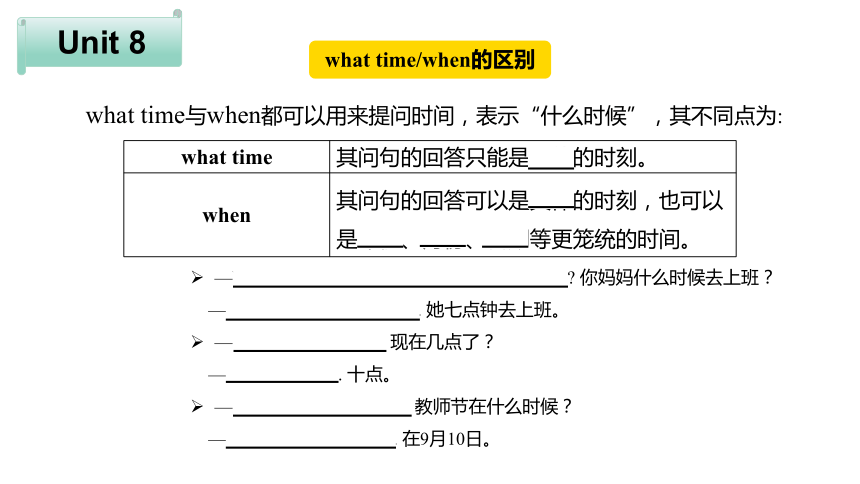
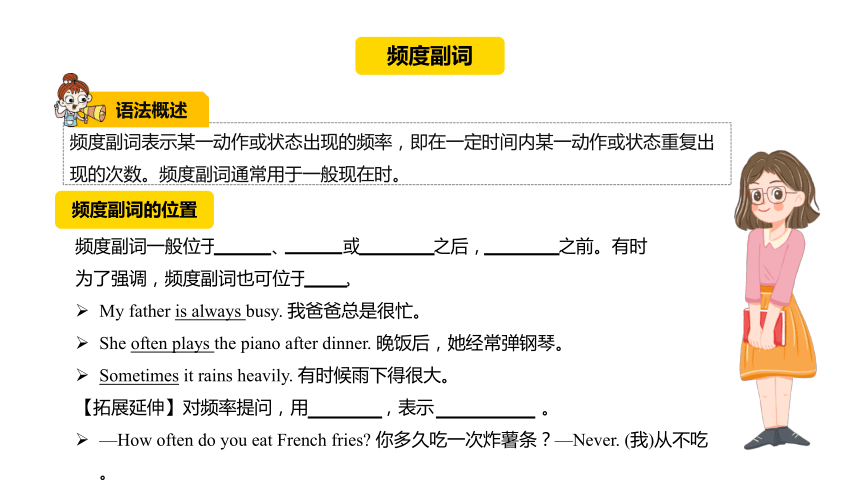
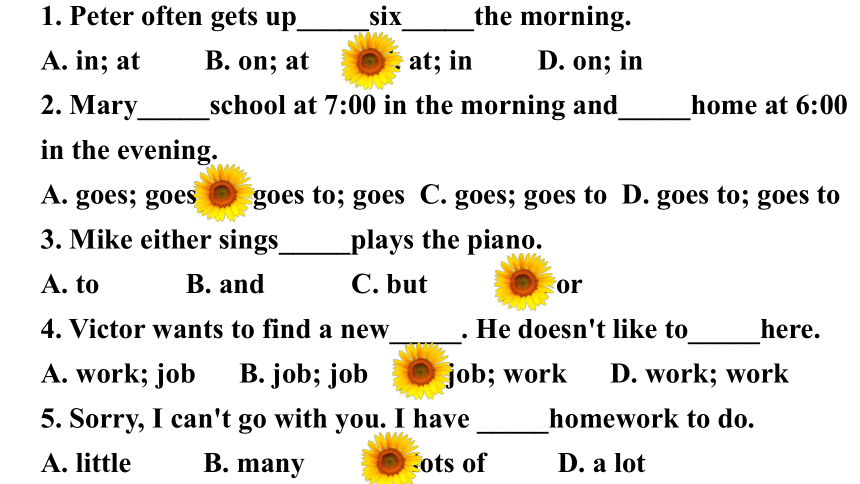
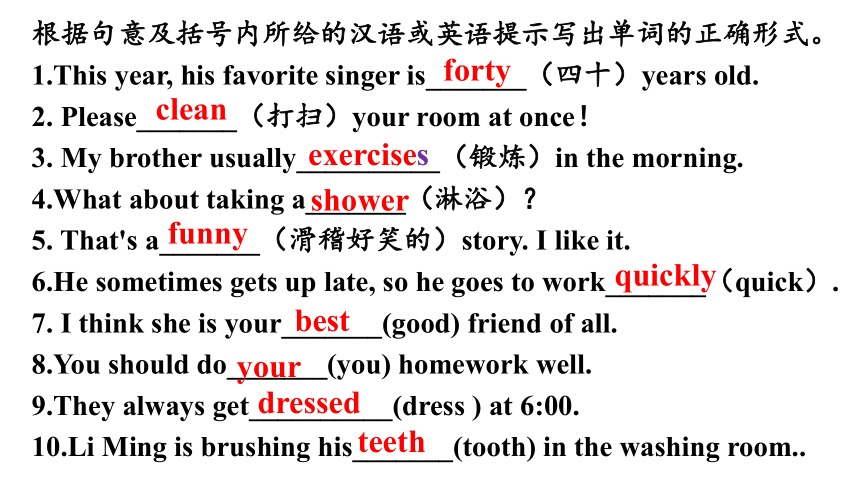
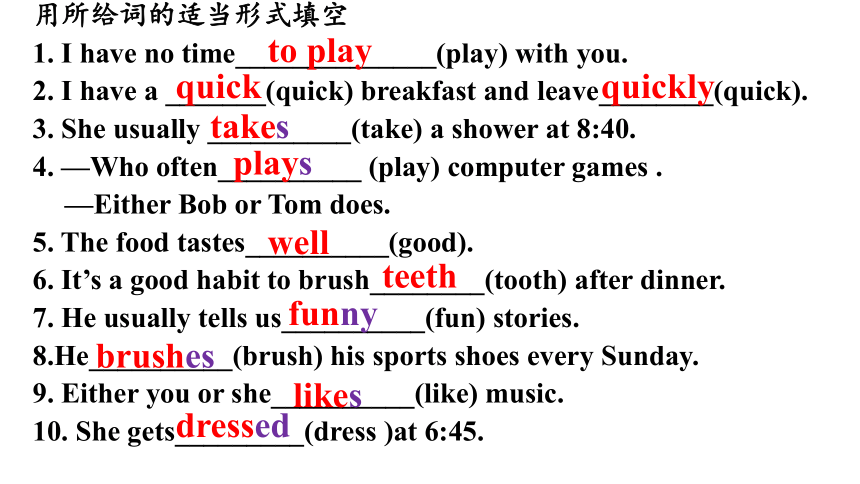
文档简介
(共67张PPT)
人教版七年级下册复习课
unit 1-unit 12语法复习
情态动词 can的用法
表能力(会):I can swim
表请求(可以):Can I help
肯定句: 主语+can+动词原形
I can dance.
否定句: 主语+can't+动词原形
I can't sing.
一般疑问句: Can+主语+动词原形
Can they play chess
无人称和数的变化:She can draw.
They can speak English.
Unit 1
情态动词can的用法
【观察与思考】
仔细观察例句, 体会并写出can的具体用法。
1. I can play basketball and Bill can swim.
(情态动词can没有 和 的变化, 其后跟动词 )
2. Bruce can’t draw.
(含有情态动词的句子变否定句时直接在can后加 )
3. —Can you speak English
—Yes, I can. /No, I can’t.
(can引导的一般疑问句作肯定回答用 __________ ,
否定回答用 ____________
人称 数
原形
not
Yes, 主语+can.
No, 主语+can’t.
Grammar
Ⅰ. 按要求完成下列各题
Tom can play soccer well.(改为否定句)
_____________________
2. My father can play the violin.(改为一般疑问句)
________________________________________
3. Linda is good at singing English songs.(改为同义句)
______________________
II. 单项选择
1. Jill ___swim very well, but her sister_______.
A. can, can B. can’t, can C. can’t does
2. ---Can Sally and Jane play the guitar
---_____. They can also play the piano.
A. Yes, they can. B. No, they can’t. C. Yes, they do.
They can’t play soccer well.
Can your father play the violin
Linda can sing English songs well.
1.—_____you play the violin —Sorry,I can't.
A.Do B.Are C.Can D.Is
2.Bob can_____and dance well.
A.sings B.to sing C.singing D.sing
3.—____you help me with my Chinese —Yes,I______.
A.Can;can't B.Can;may C.Can;can D.May;can
4.Can you show me those pictures —Sorry,________.
A.I can B.I can't C.here you are D.OK
5.—Can you swim in the river —No,_______.
A.I am B.I can C.I can't D.I am not
根据句意及括号内所给的汉语或英语提示写出单词的正确形式
1.Her brother can play the v______.He wants to be a violinist.
2. Three students play the d_______in the school show.
3.Jim can play basketball,and he can a___________ play tennis.
4.Chinese p___________are friendly to us and we like them.
5.My parents buy two________(钢琴)in the store.
6.She always tells ______________(故事) for her son before going sleeping.
7.—Do you like the_________(演出) —No,I think they're boring.
8.Mozart was a great ____________(音乐家) in the world.
9.Tom often w________a letter to his mother.
10.My brother sings_______(好).
iolin
rums
lso
eople
pianos
stories
shows
musician
rites
well
用所给词的适当形式填空
1. Welcome you to join our______________(swim) club.
2. He is a very__________player and he can play soccer very__________. (good)
3. My sister likes singing and__________(dance).
4. She likes music very much, so she is good at__________ (sing) .
5. Can you__________(show) me your picture
6. Our teacher__________(be) good at singing.
7. David reads many books, so he is good at__________(write).
8.__________your school__________(have) a rock band
9. The__________(music) are my friends.
10. These_________(people ) like_________(play) cards.
swimming
good
well
dancing
singing
show
is
writing
Does
have
musician
people
playing
what time/when的区别
what time与when都可以用来提问时间,表示“什么时候”,其不同点为:
what time 其问句的回答只能是具体的时刻。
when 其问句的回答可以是具体的时刻,也可以是年份、月份、日期等更笼统的时间。
—What time/When does your mother go to work 你妈妈什么时候去上班?
— She goes to work at seven. 她七点钟去上班。
— What time is it now 现在几点了?
— It’s ten o’clock. 十点。
— When is Teachers’ Day 教师节在什么时候?
— It’s on September 10th. 在9月10日。
Unit 8
频度副词
频度副词表示某一动作或状态出现的频率,即在一定时间内某一动作或状态重复出现的次数。频度副词通常用于一般现在时。
语法概述
频度副词的位置
频度副词一般位于be动词、助动词或情态动词之后,实义动词之前。有时为了强调,频度副词也可位于句首。
My father is always busy. 我爸爸总是很忙。
She often plays the piano after dinner. 晚饭后,她经常弹钢琴。
Sometimes it rains heavily. 有时候雨下得很大。
【拓展延伸】对频率提问,用how often,表示“多久一次”。
—How often do you eat French fries 你多久吃一次炸薯条?—Never. (我)从不吃。
1. Peter often gets up_____six_____the morning.
A. in; at B. on; at C. at; in D. on; in
2. Mary_____school at 7:00 in the morning and_____home at 6:00 in the evening.
A. goes; goes B. goes to; goes C. goes; goes to D. goes to; goes to
3. Mike either sings_____plays the piano.
A. to B. and C. but D. or
4. Victor wants to find a new_____. He doesn't like to_____here.
A. work; job B. job; job C. job; work D. work; work
5. Sorry, I can't go with you. I have _____homework to do.
A. little B. many C. lots of D. a lot
根据句意及括号内所给的汉语或英语提示写出单词的正确形式。1.This year, his favorite singer is_______(四十)years old.
2. Please_______(打扫)your room at once!
3. My brother usually__________(锻炼)in the morning.
4.What about taking a_______(淋浴)?
5. That's a_______(滑稽好笑的)story. I like it.
6.He sometimes gets up late, so he goes to work_______(quick).
7. I think she is your_______(good) friend of all.
8.You should do_______(you) homework well.
9.They always get__________(dress ) at 6:00.
10.Li Ming is brushing his_______(tooth) in the washing room..
forty
clean
exercises
shower
funny
quickly
best
your
dressed
teeth
用所给词的适当形式填空
1. I have no time______________(play) with you.
2. I have a _______(quick) breakfast and leave________(quick).
3. She usually __________(take) a shower at 8:40.
4. —Who often__________ (play) computer games .
—Either Bob or Tom does.
5. The food tastes__________(good).
6. It’s a good habit to brush________(tooth) after dinner.
7. He usually tells us__________(fun) stories.
8.He__________(brush) his sports shoes every Sunday.
9. Either you or she__________(like) music.
10. She gets_________(dress )at 6:45.
to play
quick
quickly
takes
plays
well
teeth
funny
brushes
likes
dressed
【用法辨析】how far/how long/how many/how much的区别
(一) how far 用来提问距离,多远,其答语分为两种:
(1)用长度单位表示:It is five kilometers.
(2)用时间表示: It’s twenty minutes’ walk.
(二)how long 用来提问时间,意为多久回答常用“for+时间段”。 ---How long does it take you to get to school
---It takes me 30 minutes(to get to school).
Unit 3
15 kilometers
about 5 minutes on foot
______ _____ ____ ___ from the cinema to the station
____ _____ ____ it _____ to get to the cinema
____________________________________.
_______________________________________.
It’s 15 kilometers(from the cinema to the station).
It takes about 5 minutes (to get to the cinema.)
How far is it
How long does take
注意约数
单选题。
( )1.--____________ is it from Zunyi to Guilin Hope we can arrive in 2 hours. –About 150 kilometers
A. How soon B. How long C. How far D.How much
( )2.--_________ do you watch TV every week
--For less than two hours. I often have much homework to do.
A. How many B. How much C. How long D. How often
( )3.--__________does your mother go to work every day
–By bike. A. Why B. Where C. How D. What
( )4.--_________ does it take you to do your homework every day
–About an hour.
A. How far B. How much
C. How many D. How long
C
C
C
D
( )5.--_______is it from the hotel to the zoo
–It’s ten minute’s ride.
A. How B. How long C. How far D. How many
( )6.--________ are your shoes
–They’re two hundred yuan.
A. How much B. How many
C. How long D. How far
( )7.__________ pictures are there on the wall
A. How B. How many C. How much D. How long
B
A
B
祈使句
概念
用于表达命令,请求,劝告,警告,禁止等的句子叫做祈使句,析使句最常用于表达命令,祈使句因对象(即主语)是第二人称,所以通常都省略主语。祈使句的动词都为一般现在时,句末则使用句号或感叹号来表示结束。
肯定结构;动词原型+其它成分否定结构:Don’t+肯定结构e.g. Eat in the classroom. Don’t eat in the classroom.
Do型
肯定结构:Let+宾语+动词原形+其它成分否定结构:Don’t+肯定结构Let+宾语+not+动词原形+其它成分e.g. Let him go. /Don’t let him go./Let him not go.
Let型
肯定结构:Be +表语+其它成分否定结构:Don’t+肯定结构e.g. Be a good student! Don’t be late for school!
Be型
Unit 4
(1) 表示主观的义务和必要,主要用于肯定句和疑问句,意思是“必须……,得……,要……”;由must引导的疑问句,肯定回答要用must或have/has to,否定回答要needn’t或don't/doesn't have to.意思是"不必”;
must 的否定形式 mustn't表示禁止,意思是“不能,不许”。-Must I finish my homework before six o'clock 6点之前我必须完成作业吗 -Yes, you must./No, you needn't./No, you don't have to.是的,你必须完成。/不,你没必要。You mustn't be late for school.你千万不要上学迟到。(2) 表示肯定的猜测,常用于肯定句中,意为”一定是,必然…”
You must be very tired. 你一定很累了。Mary must be in the library. 玛丽一定在图书馆里。
must 的用法
have to 的用法
表示客观需要做的事情,意思是“必须,不得不"。使用have lo时应注意的几点:
(1) have to后接动词原形,意为"必须做………;不得不做……”You have to wash my clothes first,你必须先洗我的衣服。
(2) have to有人称,数和时态的变化,其第三人称单数形式为has to.She has to help her mom make dinner,她不得不帮她妈妈做晚饭。
(3) 含有have to,has to的句子需分别借助助动词 do,does 构成疑问句或否定句。
Do they have to go home now 他们得现在回家吗
You don’t have to go if you don't want to.如果你不想去,你就不必去。
have to 的句型结构
肯定句:
否定句:
一般
疑问句:
回答:
划线提问:
I have to do my homework.
I don't have to do my homework.
Do you have to do your homework
Yes, I do. / No I don't.
What do you have to do
主语+have/has to +其他
主语+don’t have to +其他
Do +主语+don’t have to +其他
Yes, 主语+do.
No,主语+don't.
What do +主语+have to do
单项选择
1. —It's late,Teresa.______earlier next time and you'll have enough time to have breakfast.
—OK,Mom.I'll remember.
A.Get up B.Getting up C.To get up D.Gets up
2. ________this rock music,please.I'm afraid some people can't stand the noise!
A.Stopping B.Stop C.Stops D.Stopped
3. _______call me Wang Wang!It's my dog's name.
A.Not B.No C.Don't D.Doesn't
4.Tom,______ afraid of speaking in front of people.You are the best one.
A.don't B.not C.not be D.don't be
5.—Jim,_____ read books while you are walking in the street.It's very dangerous.
—OK,thank you.
A.don't B.doesn't C.won't D.can't
用所给词的适当形式填空
1.It's important for us__________(have) breakfast every day.
2. You must_______(be) here now.
3. It's my_____(one) time to be here.
4.There are many__________(rule) at our school.
5. Eric_______(wear) a pair of new trousers to school today.
6.David_______ (have) to play the guitar every Sunday.
7. _________(not) leave the books on the table.
8. Bob, help me wash these_______(dish) in the kitchen.
9.Do you often help your mother________________(make)dinner
10.Ms. Miller is very busy. She doesn't have time to clean ______(she) room.
to have
be
first
rules
wears
has
Don’t
dishes
to make/make
her
why 引导的特殊疑问句
句法分析: why 引导的特殊疑问句, 意为“为什么……?”, 用来询问某事的原因,回答时常用because。
why, where 引导的特殊疑问句
e.g. —Why does he look worried
他为什么看起来愁眉苦脸的?
—Because he lost his key.
因为他把他的钥匙丢了。
Unit 5
特殊用法:“Why don’t you +动词原形+其他 ”常用来提出建议或劝告,表示“为什么不…… ”,相当于“Why not +动词原形+其他 ”。回答时可用“Good idea(好主意)./ That sounds good(那听起来不错).”等。
e.g. Why don’t you play basketball
=Why not play basketball 为什么不打篮球呢?
—That sounds good. 听起来不错。
考题: —I feel upset because I am too heavy.
—_______ do more exercise to lose some weight
A. Why don’t B. Why not C. Why not to
考题:—Why not hold a Chinese Poetry Competition (诗歌比赛) to
welcome our motherland’s birthday
—_______. Let’s make a plan together in our group.
A. That’s all right B. Yes, please
C. Good idea D. Never mind
B
C
【拓展】其他常见的特殊疑问词(组)及其用法:
what 对姓名、物品、事件等提问 What’s your name 你叫什么名字?
how 对身体状况、方式等提问 How is your mother 你妈妈身体怎样
who 对人进行提问 Who is the girl 这个女孩是谁
when 对时间进行提问 When do you get up 你什么时候起床
whose 对某物的所属者进行提问 Whose book is this 这是谁的书
how old 对年龄进行提问 How old is your father 你爸爸多大了
what color 对颜色进行提问 What color is your ruler 你的尺子是什么颜色
Grammar focus
形容词是表示人或事物的属性或特征的词,常用来修饰或限定名词。通常在句中作定语或表语。
形容词的功能
作定语,修饰名词或代词,一般位于被修饰词之前。
作表语,位于连系动词(be、feel、look、taste、sound等)之后,构成系表结构,说明主语的情况
eg:This is an old book. 这是一本旧书。
They are beautiful. 他们很漂亮。
My mother looks young. 我的妈妈看起来很年轻。
单项选择
1. —______do you like koalas
—Because they're very cute.
A. Why B. When C. How D. What
2. I like this storybook because it's very______.
A. cute B. interesting C. smart D. kind
3.—______?
—Shanghai, China.
A. How's she B. What's her name
C. How old is she D. Where's she from
4. —What animals do you like
—______
A. They are lions B. They are beautiful
C. I like lions D. You are right
5. —Why don't you like this film
—______it's boring.
A. But Because C. And D. Before
用所给词的适当形式填空
1.There are some__________(animal) in the zoo.
2. Let’s_______(swim) in the swimming pool.
3. The koalas are very___________(interest) .
4.What do you want__________(see)first.
5. The giraffes are_____________(beauty) .
6.The elephant is one of Thailand’s___________ (symbol) .
7. It’s dangerous_________(play) with a lion.
8. Sue practices__________(play) the violin at home.
9.Koalas_______(sleep)all day.
10.It’s important __________(follow) the traffic rules on the way to school.
animals
swim
interesting
to see
beautiful
symbols
to play
playing
sleep
to follow
语法
现在进行时
用法:1. 表示现在(说话瞬间)正在进行或发生的动作。
2. 表示当前一段时间内的活动或现阶段正在进行的动作。
结构:be动词(is/am+are)+v-ing
标志:常与现在进行时连用的时间状语、时间副词或其他标志性的词有: now, look, listen, at this moment/time, these days等
Unit 6
语法
现在进行时
1. 直接在词尾加-ing。
如: play - playing read - reading go - going eat-eating
2. 以不发音的字母e结尾的单词,先去掉e再加-ing
如: take - taking have - having write - writing make - making
3. 以重读闭音节(该音节的元音为短元音)结尾,且末尾只有一个辅音字母
的单词,先双写末尾的辅音字母,再加ing
如: run - running swim - swimming sit - sitting
动词现在分词的变化规则
语法
现在进行时
1. 肯定形式:主语+be+动词ing+其他
如: I'm washing my clothes. 我在洗衣服。
2. 否定形式:主语+be not+动词ing+其他
如: He isn't reading books. 他没在读书。
3. 一般疑问句:Be+主语+动词ing+其他?
肯定回答:Yes, 主语+be.
否定回答:No, 主语+be not.
如:Are you watching TV Yes. I am. No, I am not.
现在进行时的基本句式
单项选择。
1. The boy isn’t ____ the teacher.
A. listen B. listening C. listenning to D. listening to
2. Listen! She ____ in the classroom.
A. sing B. sings C. singing D. is singing
3. —Where’s Jennifer
—She ____ in the river.
A. swims B. is swimming C. is swiming D. swimming
Exercises
改写句子
1. They are listening to a CD.(改为一般疑问句)
________ they ________ to a CD
2. He is reading a newspaper now.(改为否定句)
He ________ ________ a newspaper now.
3. He is swimming in a pool.(对划线部分提问)
________ is he ________ in a pool
4. It’s eight o’clock in Beijing now. (对划线部分提问)
________ ________ is it in Beijing now
Are listening
isn’t reading
What doing
What time
现在进行时和一般现在时的比较
现在进行时 一般现在时
概念
构成
时间状语或标志词
表示现在或现阶段正在进行的动作。
表示经常性或习惯性的动作或存在的状态,也表示主语具备的性格和能力,或陈述客观真理。
主语+be(am/is/are)+现在分词+其他.
主语+be(am/is/are)+其他.
主语+行为动词+其他.
now, right now等。
every day, often, usually, always, sometimes, in the morning等。
Unit 7
Language points
How’s the weather
What’s the weather like
如何询问天气?
描述天气的形容词
名词+后缀-y 构成描述天气的形容词
名词 形容词
cloud(云) cloudy(多云的)
wind(风) windy(多风的)
rain(雨) rainy(多雨的)
snow(雪) snowy(下雪的)
sun(太阳) sunny(晴朗的)
Language points
【注意】回答How’s the weather 可以是It’s raining, 也可以是It’s rainy, 但两者意义有区别:
A: How’s the weather 天气怎么样?
B: It’s raining. 下着雨呢。/It’s rainy. 是个阴雨天。
“It’s raining.”表示说话人说话的时候正在下雨,而 “It’s rainy.”表示某段时间是阴雨天气,说话的时候可能在下雨,也有可能没下雨。rainy的意思是“多雨的”,如: I don’t like rainy weather. 我不喜欢阴雨天气。
Exercise
Most people don't like ________(rain)days because they make people feel sad.
Tom’s mom _________ now. She always _____ for her family. (cook)
—What about going shopping
—______ (sound) like a good idea.
—How’s the weather
—It’s _______ (wind).
There are many beautiful ______ (park) in our city.
用所给单词的适当形式填空。
raining
Sounds
1
2
3
4
5
is cooking
cooks
windy
parks
Exercise
—______ is the weather like today
—It’s raining.
—_____ is it going
—It’s terrible.
—What are they doing now
—They are _________________.
选词填空
What
How
1
2
3
playing basketball
playing basketball What How
Unit 8
There be 句型
一、构成: There be+某物/某人+某地
某地有某物/某人
我的铅笔盒里有两块橡皮。
_____ ___ two erasers in my pencil box.
房子前有一棵大树。
_____ __ a tall tree in front of the house.
There is
There are
_______ ____ a ruler and two erasers in my box.
_______ ____ two erasers and a ruler in my box.
注意:
There are
结论:(1)
There is
There be句型中的主谓一致, 即就近原则
E. g. ____ ____ a book on the desk.
____ ____ some water in the cup.
There is
There is
E.g.______ _____ many trees in the park.
There are
结论:(2)
句子主语是单数可数名词或不可数名词, be动词用“is”。
句子主语是复数名词,be动词用“are”。
桌子上有一架模型飞机。
_____ ____ a model plane on the desk.
我有一架模型飞机。
I _____ a model plane.
桌子有四条腿
A desk _____ four legs.
have
There is
结论: there be 在某处有某物,即“存在有”
have/has 某人或某物+有+某物,
即“ (某物属于某人或某物)属于有”
has
there be 与 have/ has的区别
时态的变化(了解)
一般现在时:
There is a library over there.
There are five trees here.
一般过去时:
There was a library over there.
There were five trees here
一般将来时:
There will be a new book store here.
There are going to be new houses here.
下面时态,先了解:
1.—How is the today
—It’s hot. You don’t need to wear the coat.
A.weather B.traffic C.price D.cloth
【答案】A
【详解】句意:——今天天气怎么样?——天气很热。你不需要穿那件外套。
考查名词辨析。weather天气;traffic交通;price价格;cloth布。根据“It’s hot”可知此处询问天气。故选A。
2.—Is it raining in Wuhan today
— __________.
A.Yes, it does B.Yes, it is
C.No, it is D.No, it doesn’t
【答案】B
【详解】句意:——今天武汉下雨吗? ——是的。
考查一般疑问句的回答。根据“Is it raining...”可知此处是含现在进行时的一般疑问句回答,其肯定回答为:Yes, 主语 be,否定回答为:No,主语 be not。故选B。
真题感悟
3.Wang Ping’s bike ________ today, so she has to go to school by bus.
A.works B.doesn’t work C.comes D.doesn’t come
【答案】B
【详解】句意:王平的自行车今天坏了,所以她不得不乘公共汽车去上学。
考查否定句以及动词辨析。work运行;come来。根据“so she has to go to school by bus”可知,自行车不工作了,所以乘公共汽车去上学,故选B。
4.The weather is windy and snowy in ______ in Harbin.
A.July B.summer C.August D.winter
【答案】D
【详解】句意:哈尔滨冬天的天气是刮风又下雪。
考查名词辨析。July七月;summer夏天;Augusst八月;winter冬天。根据“snowy”可知,下雪是冬天,故选D。
描述某人的身高:主语+be of+形容词+height.
Our math teacher is of medium height. 我们的数学老师中等身高。
描述某人的体型:主语+be+形容词.
Lily is very short and thin. 莉莉很瘦小。
描述某人某一身体部位的特征:主语+have/has+形容词+表示身体部位的名词.
My mother has curly hair. 我妈妈留着卷发。
描述外貌的常用表达
1
2
3
Unit 9
Language points
4
描述某人的穿着打扮:主语+wear(s)+glasses/表示衣着的名词.
My sister wears glasses. 我妹妹戴着眼镜。
【拓展延伸】多个描述性形容词修饰名词时的排列顺序:
限定词
评述性词
大小形状
新旧
颜色
产地
材料
作用类别
限定词包括冠词(a, an, the)、物主代词、指示代词(this, that, these, those)和数词等,评述性形容词有cold, beautiful, great等。
two beautiful new green silk evening dresses 两件又新又漂亮的绿色丝绸晚礼服
Language points
一般疑问句用yes或no来回答;选择疑问句的两个选择项则用or连接,回答时不能用yes或no回答,而是根据实际情况选择符合事实的陈述句。
一般疑问句和选择疑问句
Language points
What does sb. look like 某人长什么样?
What does your brother look like 你哥哥长什么样?
Does sb. have straight or curly hair 某人留着直发还是卷发?
Does your English teacher have straight hair or curly hair
你的英语老师留着直发还是卷发?
Is sb. tall or short (heavy or thin) 某人高还是矮(胖还是瘦)?
Is your brother tall or short 你哥哥高还是矮?
询问外貌的常用表达
1
2
3
可数名词 不可数名词
有单数和复数之分。如:a box, two boxes。
没有复数形式。如:beef, mutton, meat, milk。
(1) 其前可直接用不定冠词a/an或具体的数词修饰,表示数量。如:a bowl ,an orange, two potatoes。
(2) 可用定冠词the修饰,表示特指,如:the girl(这个女孩)。
(1) 其前不能用不定冠词a/an或数词修饰。
(2) 可用定冠词the修饰,表示特指,如:the bread(这块面包)。
可用some, any, few, a few, many, lots of, a lot of等修饰。
可用some, any, little, a little, much, a lot of, lots of等修饰。
询问数量多少用how many。
询问量的多少用how much。
可数名词/不可数名词
Unit 10
Language points
To form the plural of most countable nouns, we add -s to the singular form. However, there are some exceptions.
Most nouns + s cake cakes
Nouns ending in a consonant + y 去掉y + ies story stories
Nouns ending in s, sh, ch or x + es bus buses wish wishes
match matches box boxes
Nouns ending in o + s or + es photo photos potato potatoes
tomato tomatoes
Nouns ending in f or fe 去掉f / fe + ves half halves life lives
Language points
Some other nouns:
man men
woman women
foot feet
tooth teeth
child children
sheep sheep
mouse mice
goose geese
oo常常变ee
男人、女人a改e,
child复数children要记准,
中、日、鹿、绵羊无变化,
单数、复数是一家.
不可数名词的量可以用 “a/an/基数词+表示量的名词(bottle/grass等) + of + 不可数名词” 表示,这些表示量的名词有单复数形式的变化。这一结构作主语时,谓语动词的单复数形式要与表示量的名词保持一致。
There is a bottle of juice on the table. 桌子上有一瓶果汁。(谓语动词is与a bottle保持一致)
There are three bowls of mutton soup on the table. 桌子上有三碗羊肉汤。(谓语动词are与three bowls保持一致)
不可数名词量的表达
some和any 既可以修饰可数名词又可以修饰不可数名词。
some 常译作“一些”,多用于肯定句,也用在疑问句中,表示期望对方肯定的答复,以示礼貌; any表示“任何”,通常用于否定句和疑问句中。
some和any的用法
I can’t see _____ tea. 我没看见茶叶。 Do you have ____ friends at school
你在学校有一些朋友吗
Would you like________coffee
你要不要来点咖啡?
How about _________ fruit juice
来点水果汁如何?
Is there ______orange juice in the fridge
冰箱里有橙汁吗?
any
any
some
some
any
① 她喜欢吃鸡肉,所以她想要一些鸡肉。
She likes ___________chicken, so she _______ some chicken/ _______________ some chicken.
② Cindy想要去钓鱼。
_______________go fishing.
= ___________________go fishing.
would like
would like 想要,愿意
would是情态动词,没有人称和数的变化。
(1) would like sth. = want sth. 想要某物 (want有人称和数量变化)
(2) would like to do sth.= want to do sth.想做某事
to eat/ eating
wants
would like
Cindy wants to
Cindy would like to
一般过去时态
定义:表示过去某一时间所发生的动作或存在的状态。
谓语动词:要用一般过去式。
时间标志:
1. last+时间名词 :last week, last month(上个月), last year(去年)
2.时间段+ago:two months ago(两个月前)
3.in +过去的时间:in 1990 (在1990年), in those days (在那些日子里)
4.其他:yesterday(昨天),just now(刚才),等表示过去的时间状语。
Unit 11
含有be动词的一般过去时
Jim was in Beijing last year.
Jim wasn’t in Beijing last year.
—Was Jim in Beijing last year
—Yes, he was.
No, he wasn’t.
Where was Jim last year
否定句:主语 + was/ were + not + 其他.
一般疑问句:Was/ Were + 主语 + 其他
肯定回答:Yes, 主语 + was/ were.
否定回答:No, 主语 + wasn’t/weren’t.
特殊疑问句:特殊疑问词 + was/ were + 主语 + 其他
肯定句:主语 + was/ were + 其他.
was 用于单数人称
(I,she,he,it,Lucy)
were 用于第二人称
和复数人称。
(you,they,we)
He cleaned the room yesterday.
He didn’t clean the room yesterday.
—Did he clean the room yesterday
—Yes, he did. / No, he didn’t.
What did he do yesterday
含有行为动词的一般过去时
肯定句:主语 + 动词过去式+ 其他.
否定句:主语 + didn’t + 动词原形 + 其他.
一般疑问句:Did+ 主语 + 动词原形 + 其他
肯定回答:Yes, 主语 + did.
否定回答:No, 主语 + didn’t.
特殊疑问句:特殊疑问词 + did+ 主语 + 动词原形 + 其他
规则动词过去式的构成
构成规则 原形 过 去 式
一般在动词原形末尾加-ed work play worked
played
结尾是e的动词加-d hope live hoped
lived
末尾只有一个辅音字母的重读闭音节词,先双写这个辅音字母,再加-ed(辅元辅) stop shop stopped
shopped
结尾是“辅音字母+y”的动词,先变“y”为“ i”再加-ed study worry studied
worried
动词过去式变化规则——不规则变化
动词原形 过去式 过去分词
cost(花费)
cut(切) read(读) run(跑)
become(变成) build(建立)
win(赢) feed(喂养) take(拿)
eat(吃) cost
cost
cut
cut
read
read
AAA型
ran
run
became
built
built
won
won
fed
fed
took
taken
ate
eaten
become
ABA型
ABB型
ABC型
Exercise
用所给动词的适当形式填空。
1.They _______ (take) lots of photos in the zoo yesterday.
2.She _______ (do) her homework yesterday evening.
3.I _______ (go) to the movies with my parents last night.
4.Mike _______ (have) a great time at the party yesterday.
5._______ you _______ (pick) flowers last weekend
took
did
went
had
Did pick
一般过去时的特殊疑问句
含be动词的特殊疑问句 特殊疑问词 + was/were + 主语 + 其他
特殊疑问词(主语) + was/were + 其他
含实义动词的特殊疑问句 特殊疑问词 + did + 主语 + 动词原形 + 其他
特殊疑问词(主语) + 动词过去式 + 其他
— How was your trip 你的旅行怎么样?
— It was great. 非常好。
— Who was your English teacher last term 上学期谁是你的英语老师?
— Mrs Li. 李老师。
— What did Lucy have for dinner 露西晚餐吃的什么?
— She had rice. 她吃的米饭。
— Who gave you the schoolbag 谁送给你的这个书包?
— My mother did. 我妈妈给我的。
Unit 12
Language points
一般过去时和一般现在时的区别
一般过去时 一般现在时
用法不同 表示过去某个时间发生的动作或存在的状态。 I played badminton with my father last weekend. 我上周末和爸爸一起打羽毛球了。 表示经常发生或习惯性的动作或现在的状态。
I often play badminton with my father. 我经常和爸爸一起打羽毛球。
时间状语不同 一般过去时常与表示过去的时间状语连用,如last week, yesterday, two days ago, last month等。 He went to Japan last month. 他上个月去了日本。 一般现在时常与表示现在的时间状语连用,如every day, on weekends 等。
We read English every morning. 我们每天早上读英语。
Language points
一般过去时 一般现在时
谓语动词不同 谓语动词使用过去式,没有人称和数的变化( was和were除外) Julia did her homework and I did some reading after class yesterday. 昨天下课后,朱莉娅做作业,我看书。 谓语动词有人称和数的变化。第三人称单数作主语时,谓语动词要使用第三人称单数形式(be动词用is);其他人称作主语时,则使用动词原形(be动词用am或are)。
My mother enjoys going shopping and I enjoy traveling. 我妈妈喜欢购物,我喜欢旅行。
一般过去时和一般现在时的区别
Exercises
单项选择
1.—Where did you go last winter vacation
— I ______ to London with my family.
A. go B. have gone C. went D. was going
2.—Wendy, how long have you had the new smartphone
—A couple of days. I ______ it last week.
A. bought B. buy C. will buy D. have bought
3.—Jack, you look more handsome in your new shirt today.
—Oh, really I ______ it in a cheap store with my mom.
A. buy B. will buy C. bought D.have bought
C
A
C
Exercises
单项选择
4.—What did you do the day before yesterday
—I ______ for an English test.
A. study B. studied C. studying D.studies
5.They don’t live here any longer. They ______to Chengdu last month.
A. move B. moved C. will move D. are moving
6.—You can’t smoke here.
—Sorry, I ______ the sign.
A. don’t see B. didn’t see C. haven’t seen D. won’t see
B
B
B
人教版七年级下册复习课
unit 1-unit 12语法复习
情态动词 can的用法
表能力(会):I can swim
表请求(可以):Can I help
肯定句: 主语+can+动词原形
I can dance.
否定句: 主语+can't+动词原形
I can't sing.
一般疑问句: Can+主语+动词原形
Can they play chess
无人称和数的变化:She can draw.
They can speak English.
Unit 1
情态动词can的用法
【观察与思考】
仔细观察例句, 体会并写出can的具体用法。
1. I can play basketball and Bill can swim.
(情态动词can没有 和 的变化, 其后跟动词 )
2. Bruce can’t draw.
(含有情态动词的句子变否定句时直接在can后加 )
3. —Can you speak English
—Yes, I can. /No, I can’t.
(can引导的一般疑问句作肯定回答用 __________ ,
否定回答用 ____________
人称 数
原形
not
Yes, 主语+can.
No, 主语+can’t.
Grammar
Ⅰ. 按要求完成下列各题
Tom can play soccer well.(改为否定句)
_____________________
2. My father can play the violin.(改为一般疑问句)
________________________________________
3. Linda is good at singing English songs.(改为同义句)
______________________
II. 单项选择
1. Jill ___swim very well, but her sister_______.
A. can, can B. can’t, can C. can’t does
2. ---Can Sally and Jane play the guitar
---_____. They can also play the piano.
A. Yes, they can. B. No, they can’t. C. Yes, they do.
They can’t play soccer well.
Can your father play the violin
Linda can sing English songs well.
1.—_____you play the violin —Sorry,I can't.
A.Do B.Are C.Can D.Is
2.Bob can_____and dance well.
A.sings B.to sing C.singing D.sing
3.—____you help me with my Chinese —Yes,I______.
A.Can;can't B.Can;may C.Can;can D.May;can
4.Can you show me those pictures —Sorry,________.
A.I can B.I can't C.here you are D.OK
5.—Can you swim in the river —No,_______.
A.I am B.I can C.I can't D.I am not
根据句意及括号内所给的汉语或英语提示写出单词的正确形式
1.Her brother can play the v______.He wants to be a violinist.
2. Three students play the d_______in the school show.
3.Jim can play basketball,and he can a___________ play tennis.
4.Chinese p___________are friendly to us and we like them.
5.My parents buy two________(钢琴)in the store.
6.She always tells ______________(故事) for her son before going sleeping.
7.—Do you like the_________(演出) —No,I think they're boring.
8.Mozart was a great ____________(音乐家) in the world.
9.Tom often w________a letter to his mother.
10.My brother sings_______(好).
iolin
rums
lso
eople
pianos
stories
shows
musician
rites
well
用所给词的适当形式填空
1. Welcome you to join our______________(swim) club.
2. He is a very__________player and he can play soccer very__________. (good)
3. My sister likes singing and__________(dance).
4. She likes music very much, so she is good at__________ (sing) .
5. Can you__________(show) me your picture
6. Our teacher__________(be) good at singing.
7. David reads many books, so he is good at__________(write).
8.__________your school__________(have) a rock band
9. The__________(music) are my friends.
10. These_________(people ) like_________(play) cards.
swimming
good
well
dancing
singing
show
is
writing
Does
have
musician
people
playing
what time/when的区别
what time与when都可以用来提问时间,表示“什么时候”,其不同点为:
what time 其问句的回答只能是具体的时刻。
when 其问句的回答可以是具体的时刻,也可以是年份、月份、日期等更笼统的时间。
—What time/When does your mother go to work 你妈妈什么时候去上班?
— She goes to work at seven. 她七点钟去上班。
— What time is it now 现在几点了?
— It’s ten o’clock. 十点。
— When is Teachers’ Day 教师节在什么时候?
— It’s on September 10th. 在9月10日。
Unit 8
频度副词
频度副词表示某一动作或状态出现的频率,即在一定时间内某一动作或状态重复出现的次数。频度副词通常用于一般现在时。
语法概述
频度副词的位置
频度副词一般位于be动词、助动词或情态动词之后,实义动词之前。有时为了强调,频度副词也可位于句首。
My father is always busy. 我爸爸总是很忙。
She often plays the piano after dinner. 晚饭后,她经常弹钢琴。
Sometimes it rains heavily. 有时候雨下得很大。
【拓展延伸】对频率提问,用how often,表示“多久一次”。
—How often do you eat French fries 你多久吃一次炸薯条?—Never. (我)从不吃。
1. Peter often gets up_____six_____the morning.
A. in; at B. on; at C. at; in D. on; in
2. Mary_____school at 7:00 in the morning and_____home at 6:00 in the evening.
A. goes; goes B. goes to; goes C. goes; goes to D. goes to; goes to
3. Mike either sings_____plays the piano.
A. to B. and C. but D. or
4. Victor wants to find a new_____. He doesn't like to_____here.
A. work; job B. job; job C. job; work D. work; work
5. Sorry, I can't go with you. I have _____homework to do.
A. little B. many C. lots of D. a lot
根据句意及括号内所给的汉语或英语提示写出单词的正确形式。1.This year, his favorite singer is_______(四十)years old.
2. Please_______(打扫)your room at once!
3. My brother usually__________(锻炼)in the morning.
4.What about taking a_______(淋浴)?
5. That's a_______(滑稽好笑的)story. I like it.
6.He sometimes gets up late, so he goes to work_______(quick).
7. I think she is your_______(good) friend of all.
8.You should do_______(you) homework well.
9.They always get__________(dress ) at 6:00.
10.Li Ming is brushing his_______(tooth) in the washing room..
forty
clean
exercises
shower
funny
quickly
best
your
dressed
teeth
用所给词的适当形式填空
1. I have no time______________(play) with you.
2. I have a _______(quick) breakfast and leave________(quick).
3. She usually __________(take) a shower at 8:40.
4. —Who often__________ (play) computer games .
—Either Bob or Tom does.
5. The food tastes__________(good).
6. It’s a good habit to brush________(tooth) after dinner.
7. He usually tells us__________(fun) stories.
8.He__________(brush) his sports shoes every Sunday.
9. Either you or she__________(like) music.
10. She gets_________(dress )at 6:45.
to play
quick
quickly
takes
plays
well
teeth
funny
brushes
likes
dressed
【用法辨析】how far/how long/how many/how much的区别
(一) how far 用来提问距离,多远,其答语分为两种:
(1)用长度单位表示:It is five kilometers.
(2)用时间表示: It’s twenty minutes’ walk.
(二)how long 用来提问时间,意为多久回答常用“for+时间段”。 ---How long does it take you to get to school
---It takes me 30 minutes(to get to school).
Unit 3
15 kilometers
about 5 minutes on foot
______ _____ ____ ___ from the cinema to the station
____ _____ ____ it _____ to get to the cinema
____________________________________.
_______________________________________.
It’s 15 kilometers(from the cinema to the station).
It takes about 5 minutes (to get to the cinema.)
How far is it
How long does take
注意约数
单选题。
( )1.--____________ is it from Zunyi to Guilin Hope we can arrive in 2 hours. –About 150 kilometers
A. How soon B. How long C. How far D.How much
( )2.--_________ do you watch TV every week
--For less than two hours. I often have much homework to do.
A. How many B. How much C. How long D. How often
( )3.--__________does your mother go to work every day
–By bike. A. Why B. Where C. How D. What
( )4.--_________ does it take you to do your homework every day
–About an hour.
A. How far B. How much
C. How many D. How long
C
C
C
D
( )5.--_______is it from the hotel to the zoo
–It’s ten minute’s ride.
A. How B. How long C. How far D. How many
( )6.--________ are your shoes
–They’re two hundred yuan.
A. How much B. How many
C. How long D. How far
( )7.__________ pictures are there on the wall
A. How B. How many C. How much D. How long
B
A
B
祈使句
概念
用于表达命令,请求,劝告,警告,禁止等的句子叫做祈使句,析使句最常用于表达命令,祈使句因对象(即主语)是第二人称,所以通常都省略主语。祈使句的动词都为一般现在时,句末则使用句号或感叹号来表示结束。
肯定结构;动词原型+其它成分否定结构:Don’t+肯定结构e.g. Eat in the classroom. Don’t eat in the classroom.
Do型
肯定结构:Let+宾语+动词原形+其它成分否定结构:Don’t+肯定结构Let+宾语+not+动词原形+其它成分e.g. Let him go. /Don’t let him go./Let him not go.
Let型
肯定结构:Be +表语+其它成分否定结构:Don’t+肯定结构e.g. Be a good student! Don’t be late for school!
Be型
Unit 4
(1) 表示主观的义务和必要,主要用于肯定句和疑问句,意思是“必须……,得……,要……”;由must引导的疑问句,肯定回答要用must或have/has to,否定回答要needn’t或don't/doesn't have to.意思是"不必”;
must 的否定形式 mustn't表示禁止,意思是“不能,不许”。-Must I finish my homework before six o'clock 6点之前我必须完成作业吗 -Yes, you must./No, you needn't./No, you don't have to.是的,你必须完成。/不,你没必要。You mustn't be late for school.你千万不要上学迟到。(2) 表示肯定的猜测,常用于肯定句中,意为”一定是,必然…”
You must be very tired. 你一定很累了。Mary must be in the library. 玛丽一定在图书馆里。
must 的用法
have to 的用法
表示客观需要做的事情,意思是“必须,不得不"。使用have lo时应注意的几点:
(1) have to后接动词原形,意为"必须做………;不得不做……”You have to wash my clothes first,你必须先洗我的衣服。
(2) have to有人称,数和时态的变化,其第三人称单数形式为has to.She has to help her mom make dinner,她不得不帮她妈妈做晚饭。
(3) 含有have to,has to的句子需分别借助助动词 do,does 构成疑问句或否定句。
Do they have to go home now 他们得现在回家吗
You don’t have to go if you don't want to.如果你不想去,你就不必去。
have to 的句型结构
肯定句:
否定句:
一般
疑问句:
回答:
划线提问:
I have to do my homework.
I don't have to do my homework.
Do you have to do your homework
Yes, I do. / No I don't.
What do you have to do
主语+have/has to +其他
主语+don’t have to +其他
Do +主语+don’t have to +其他
Yes, 主语+do.
No,主语+don't.
What do +主语+have to do
单项选择
1. —It's late,Teresa.______earlier next time and you'll have enough time to have breakfast.
—OK,Mom.I'll remember.
A.Get up B.Getting up C.To get up D.Gets up
2. ________this rock music,please.I'm afraid some people can't stand the noise!
A.Stopping B.Stop C.Stops D.Stopped
3. _______call me Wang Wang!It's my dog's name.
A.Not B.No C.Don't D.Doesn't
4.Tom,______ afraid of speaking in front of people.You are the best one.
A.don't B.not C.not be D.don't be
5.—Jim,_____ read books while you are walking in the street.It's very dangerous.
—OK,thank you.
A.don't B.doesn't C.won't D.can't
用所给词的适当形式填空
1.It's important for us__________(have) breakfast every day.
2. You must_______(be) here now.
3. It's my_____(one) time to be here.
4.There are many__________(rule) at our school.
5. Eric_______(wear) a pair of new trousers to school today.
6.David_______ (have) to play the guitar every Sunday.
7. _________(not) leave the books on the table.
8. Bob, help me wash these_______(dish) in the kitchen.
9.Do you often help your mother________________(make)dinner
10.Ms. Miller is very busy. She doesn't have time to clean ______(she) room.
to have
be
first
rules
wears
has
Don’t
dishes
to make/make
her
why 引导的特殊疑问句
句法分析: why 引导的特殊疑问句, 意为“为什么……?”, 用来询问某事的原因,回答时常用because。
why, where 引导的特殊疑问句
e.g. —Why does he look worried
他为什么看起来愁眉苦脸的?
—Because he lost his key.
因为他把他的钥匙丢了。
Unit 5
特殊用法:“Why don’t you +动词原形+其他 ”常用来提出建议或劝告,表示“为什么不…… ”,相当于“Why not +动词原形+其他 ”。回答时可用“Good idea(好主意)./ That sounds good(那听起来不错).”等。
e.g. Why don’t you play basketball
=Why not play basketball 为什么不打篮球呢?
—That sounds good. 听起来不错。
考题: —I feel upset because I am too heavy.
—_______ do more exercise to lose some weight
A. Why don’t B. Why not C. Why not to
考题:—Why not hold a Chinese Poetry Competition (诗歌比赛) to
welcome our motherland’s birthday
—_______. Let’s make a plan together in our group.
A. That’s all right B. Yes, please
C. Good idea D. Never mind
B
C
【拓展】其他常见的特殊疑问词(组)及其用法:
what 对姓名、物品、事件等提问 What’s your name 你叫什么名字?
how 对身体状况、方式等提问 How is your mother 你妈妈身体怎样
who 对人进行提问 Who is the girl 这个女孩是谁
when 对时间进行提问 When do you get up 你什么时候起床
whose 对某物的所属者进行提问 Whose book is this 这是谁的书
how old 对年龄进行提问 How old is your father 你爸爸多大了
what color 对颜色进行提问 What color is your ruler 你的尺子是什么颜色
Grammar focus
形容词是表示人或事物的属性或特征的词,常用来修饰或限定名词。通常在句中作定语或表语。
形容词的功能
作定语,修饰名词或代词,一般位于被修饰词之前。
作表语,位于连系动词(be、feel、look、taste、sound等)之后,构成系表结构,说明主语的情况
eg:This is an old book. 这是一本旧书。
They are beautiful. 他们很漂亮。
My mother looks young. 我的妈妈看起来很年轻。
单项选择
1. —______do you like koalas
—Because they're very cute.
A. Why B. When C. How D. What
2. I like this storybook because it's very______.
A. cute B. interesting C. smart D. kind
3.—______?
—Shanghai, China.
A. How's she B. What's her name
C. How old is she D. Where's she from
4. —What animals do you like
—______
A. They are lions B. They are beautiful
C. I like lions D. You are right
5. —Why don't you like this film
—______it's boring.
A. But Because C. And D. Before
用所给词的适当形式填空
1.There are some__________(animal) in the zoo.
2. Let’s_______(swim) in the swimming pool.
3. The koalas are very___________(interest) .
4.What do you want__________(see)first.
5. The giraffes are_____________(beauty) .
6.The elephant is one of Thailand’s___________ (symbol) .
7. It’s dangerous_________(play) with a lion.
8. Sue practices__________(play) the violin at home.
9.Koalas_______(sleep)all day.
10.It’s important __________(follow) the traffic rules on the way to school.
animals
swim
interesting
to see
beautiful
symbols
to play
playing
sleep
to follow
语法
现在进行时
用法:1. 表示现在(说话瞬间)正在进行或发生的动作。
2. 表示当前一段时间内的活动或现阶段正在进行的动作。
结构:be动词(is/am+are)+v-ing
标志:常与现在进行时连用的时间状语、时间副词或其他标志性的词有: now, look, listen, at this moment/time, these days等
Unit 6
语法
现在进行时
1. 直接在词尾加-ing。
如: play - playing read - reading go - going eat-eating
2. 以不发音的字母e结尾的单词,先去掉e再加-ing
如: take - taking have - having write - writing make - making
3. 以重读闭音节(该音节的元音为短元音)结尾,且末尾只有一个辅音字母
的单词,先双写末尾的辅音字母,再加ing
如: run - running swim - swimming sit - sitting
动词现在分词的变化规则
语法
现在进行时
1. 肯定形式:主语+be+动词ing+其他
如: I'm washing my clothes. 我在洗衣服。
2. 否定形式:主语+be not+动词ing+其他
如: He isn't reading books. 他没在读书。
3. 一般疑问句:Be+主语+动词ing+其他?
肯定回答:Yes, 主语+be.
否定回答:No, 主语+be not.
如:Are you watching TV Yes. I am. No, I am not.
现在进行时的基本句式
单项选择。
1. The boy isn’t ____ the teacher.
A. listen B. listening C. listenning to D. listening to
2. Listen! She ____ in the classroom.
A. sing B. sings C. singing D. is singing
3. —Where’s Jennifer
—She ____ in the river.
A. swims B. is swimming C. is swiming D. swimming
Exercises
改写句子
1. They are listening to a CD.(改为一般疑问句)
________ they ________ to a CD
2. He is reading a newspaper now.(改为否定句)
He ________ ________ a newspaper now.
3. He is swimming in a pool.(对划线部分提问)
________ is he ________ in a pool
4. It’s eight o’clock in Beijing now. (对划线部分提问)
________ ________ is it in Beijing now
Are listening
isn’t reading
What doing
What time
现在进行时和一般现在时的比较
现在进行时 一般现在时
概念
构成
时间状语或标志词
表示现在或现阶段正在进行的动作。
表示经常性或习惯性的动作或存在的状态,也表示主语具备的性格和能力,或陈述客观真理。
主语+be(am/is/are)+现在分词+其他.
主语+be(am/is/are)+其他.
主语+行为动词+其他.
now, right now等。
every day, often, usually, always, sometimes, in the morning等。
Unit 7
Language points
How’s the weather
What’s the weather like
如何询问天气?
描述天气的形容词
名词+后缀-y 构成描述天气的形容词
名词 形容词
cloud(云) cloudy(多云的)
wind(风) windy(多风的)
rain(雨) rainy(多雨的)
snow(雪) snowy(下雪的)
sun(太阳) sunny(晴朗的)
Language points
【注意】回答How’s the weather 可以是It’s raining, 也可以是It’s rainy, 但两者意义有区别:
A: How’s the weather 天气怎么样?
B: It’s raining. 下着雨呢。/It’s rainy. 是个阴雨天。
“It’s raining.”表示说话人说话的时候正在下雨,而 “It’s rainy.”表示某段时间是阴雨天气,说话的时候可能在下雨,也有可能没下雨。rainy的意思是“多雨的”,如: I don’t like rainy weather. 我不喜欢阴雨天气。
Exercise
Most people don't like ________(rain)days because they make people feel sad.
Tom’s mom _________ now. She always _____ for her family. (cook)
—What about going shopping
—______ (sound) like a good idea.
—How’s the weather
—It’s _______ (wind).
There are many beautiful ______ (park) in our city.
用所给单词的适当形式填空。
raining
Sounds
1
2
3
4
5
is cooking
cooks
windy
parks
Exercise
—______ is the weather like today
—It’s raining.
—_____ is it going
—It’s terrible.
—What are they doing now
—They are _________________.
选词填空
What
How
1
2
3
playing basketball
playing basketball What How
Unit 8
There be 句型
一、构成: There be+某物/某人+某地
某地有某物/某人
我的铅笔盒里有两块橡皮。
_____ ___ two erasers in my pencil box.
房子前有一棵大树。
_____ __ a tall tree in front of the house.
There is
There are
_______ ____ a ruler and two erasers in my box.
_______ ____ two erasers and a ruler in my box.
注意:
There are
结论:(1)
There is
There be句型中的主谓一致, 即就近原则
E. g. ____ ____ a book on the desk.
____ ____ some water in the cup.
There is
There is
E.g.______ _____ many trees in the park.
There are
结论:(2)
句子主语是单数可数名词或不可数名词, be动词用“is”。
句子主语是复数名词,be动词用“are”。
桌子上有一架模型飞机。
_____ ____ a model plane on the desk.
我有一架模型飞机。
I _____ a model plane.
桌子有四条腿
A desk _____ four legs.
have
There is
结论: there be 在某处有某物,即“存在有”
have/has 某人或某物+有+某物,
即“ (某物属于某人或某物)属于有”
has
there be 与 have/ has的区别
时态的变化(了解)
一般现在时:
There is a library over there.
There are five trees here.
一般过去时:
There was a library over there.
There were five trees here
一般将来时:
There will be a new book store here.
There are going to be new houses here.
下面时态,先了解:
1.—How is the today
—It’s hot. You don’t need to wear the coat.
A.weather B.traffic C.price D.cloth
【答案】A
【详解】句意:——今天天气怎么样?——天气很热。你不需要穿那件外套。
考查名词辨析。weather天气;traffic交通;price价格;cloth布。根据“It’s hot”可知此处询问天气。故选A。
2.—Is it raining in Wuhan today
— __________.
A.Yes, it does B.Yes, it is
C.No, it is D.No, it doesn’t
【答案】B
【详解】句意:——今天武汉下雨吗? ——是的。
考查一般疑问句的回答。根据“Is it raining...”可知此处是含现在进行时的一般疑问句回答,其肯定回答为:Yes, 主语 be,否定回答为:No,主语 be not。故选B。
真题感悟
3.Wang Ping’s bike ________ today, so she has to go to school by bus.
A.works B.doesn’t work C.comes D.doesn’t come
【答案】B
【详解】句意:王平的自行车今天坏了,所以她不得不乘公共汽车去上学。
考查否定句以及动词辨析。work运行;come来。根据“so she has to go to school by bus”可知,自行车不工作了,所以乘公共汽车去上学,故选B。
4.The weather is windy and snowy in ______ in Harbin.
A.July B.summer C.August D.winter
【答案】D
【详解】句意:哈尔滨冬天的天气是刮风又下雪。
考查名词辨析。July七月;summer夏天;Augusst八月;winter冬天。根据“snowy”可知,下雪是冬天,故选D。
描述某人的身高:主语+be of+形容词+height.
Our math teacher is of medium height. 我们的数学老师中等身高。
描述某人的体型:主语+be+形容词.
Lily is very short and thin. 莉莉很瘦小。
描述某人某一身体部位的特征:主语+have/has+形容词+表示身体部位的名词.
My mother has curly hair. 我妈妈留着卷发。
描述外貌的常用表达
1
2
3
Unit 9
Language points
4
描述某人的穿着打扮:主语+wear(s)+glasses/表示衣着的名词.
My sister wears glasses. 我妹妹戴着眼镜。
【拓展延伸】多个描述性形容词修饰名词时的排列顺序:
限定词
评述性词
大小形状
新旧
颜色
产地
材料
作用类别
限定词包括冠词(a, an, the)、物主代词、指示代词(this, that, these, those)和数词等,评述性形容词有cold, beautiful, great等。
two beautiful new green silk evening dresses 两件又新又漂亮的绿色丝绸晚礼服
Language points
一般疑问句用yes或no来回答;选择疑问句的两个选择项则用or连接,回答时不能用yes或no回答,而是根据实际情况选择符合事实的陈述句。
一般疑问句和选择疑问句
Language points
What does sb. look like 某人长什么样?
What does your brother look like 你哥哥长什么样?
Does sb. have straight or curly hair 某人留着直发还是卷发?
Does your English teacher have straight hair or curly hair
你的英语老师留着直发还是卷发?
Is sb. tall or short (heavy or thin) 某人高还是矮(胖还是瘦)?
Is your brother tall or short 你哥哥高还是矮?
询问外貌的常用表达
1
2
3
可数名词 不可数名词
有单数和复数之分。如:a box, two boxes。
没有复数形式。如:beef, mutton, meat, milk。
(1) 其前可直接用不定冠词a/an或具体的数词修饰,表示数量。如:a bowl ,an orange, two potatoes。
(2) 可用定冠词the修饰,表示特指,如:the girl(这个女孩)。
(1) 其前不能用不定冠词a/an或数词修饰。
(2) 可用定冠词the修饰,表示特指,如:the bread(这块面包)。
可用some, any, few, a few, many, lots of, a lot of等修饰。
可用some, any, little, a little, much, a lot of, lots of等修饰。
询问数量多少用how many。
询问量的多少用how much。
可数名词/不可数名词
Unit 10
Language points
To form the plural of most countable nouns, we add -s to the singular form. However, there are some exceptions.
Most nouns + s cake cakes
Nouns ending in a consonant + y 去掉y + ies story stories
Nouns ending in s, sh, ch or x + es bus buses wish wishes
match matches box boxes
Nouns ending in o + s or + es photo photos potato potatoes
tomato tomatoes
Nouns ending in f or fe 去掉f / fe + ves half halves life lives
Language points
Some other nouns:
man men
woman women
foot feet
tooth teeth
child children
sheep sheep
mouse mice
goose geese
oo常常变ee
男人、女人a改e,
child复数children要记准,
中、日、鹿、绵羊无变化,
单数、复数是一家.
不可数名词的量可以用 “a/an/基数词+表示量的名词(bottle/grass等) + of + 不可数名词” 表示,这些表示量的名词有单复数形式的变化。这一结构作主语时,谓语动词的单复数形式要与表示量的名词保持一致。
There is a bottle of juice on the table. 桌子上有一瓶果汁。(谓语动词is与a bottle保持一致)
There are three bowls of mutton soup on the table. 桌子上有三碗羊肉汤。(谓语动词are与three bowls保持一致)
不可数名词量的表达
some和any 既可以修饰可数名词又可以修饰不可数名词。
some 常译作“一些”,多用于肯定句,也用在疑问句中,表示期望对方肯定的答复,以示礼貌; any表示“任何”,通常用于否定句和疑问句中。
some和any的用法
I can’t see _____ tea. 我没看见茶叶。 Do you have ____ friends at school
你在学校有一些朋友吗
Would you like________coffee
你要不要来点咖啡?
How about _________ fruit juice
来点水果汁如何?
Is there ______orange juice in the fridge
冰箱里有橙汁吗?
any
any
some
some
any
① 她喜欢吃鸡肉,所以她想要一些鸡肉。
She likes ___________chicken, so she _______ some chicken/ _______________ some chicken.
② Cindy想要去钓鱼。
_______________go fishing.
= ___________________go fishing.
would like
would like 想要,愿意
would是情态动词,没有人称和数的变化。
(1) would like sth. = want sth. 想要某物 (want有人称和数量变化)
(2) would like to do sth.= want to do sth.想做某事
to eat/ eating
wants
would like
Cindy wants to
Cindy would like to
一般过去时态
定义:表示过去某一时间所发生的动作或存在的状态。
谓语动词:要用一般过去式。
时间标志:
1. last+时间名词 :last week, last month(上个月), last year(去年)
2.时间段+ago:two months ago(两个月前)
3.in +过去的时间:in 1990 (在1990年), in those days (在那些日子里)
4.其他:yesterday(昨天),just now(刚才),等表示过去的时间状语。
Unit 11
含有be动词的一般过去时
Jim was in Beijing last year.
Jim wasn’t in Beijing last year.
—Was Jim in Beijing last year
—Yes, he was.
No, he wasn’t.
Where was Jim last year
否定句:主语 + was/ were + not + 其他.
一般疑问句:Was/ Were + 主语 + 其他
肯定回答:Yes, 主语 + was/ were.
否定回答:No, 主语 + wasn’t/weren’t.
特殊疑问句:特殊疑问词 + was/ were + 主语 + 其他
肯定句:主语 + was/ were + 其他.
was 用于单数人称
(I,she,he,it,Lucy)
were 用于第二人称
和复数人称。
(you,they,we)
He cleaned the room yesterday.
He didn’t clean the room yesterday.
—Did he clean the room yesterday
—Yes, he did. / No, he didn’t.
What did he do yesterday
含有行为动词的一般过去时
肯定句:主语 + 动词过去式+ 其他.
否定句:主语 + didn’t + 动词原形 + 其他.
一般疑问句:Did+ 主语 + 动词原形 + 其他
肯定回答:Yes, 主语 + did.
否定回答:No, 主语 + didn’t.
特殊疑问句:特殊疑问词 + did+ 主语 + 动词原形 + 其他
规则动词过去式的构成
构成规则 原形 过 去 式
一般在动词原形末尾加-ed work play worked
played
结尾是e的动词加-d hope live hoped
lived
末尾只有一个辅音字母的重读闭音节词,先双写这个辅音字母,再加-ed(辅元辅) stop shop stopped
shopped
结尾是“辅音字母+y”的动词,先变“y”为“ i”再加-ed study worry studied
worried
动词过去式变化规则——不规则变化
动词原形 过去式 过去分词
cost(花费)
cut(切) read(读) run(跑)
become(变成) build(建立)
win(赢) feed(喂养) take(拿)
eat(吃) cost
cost
cut
cut
read
read
AAA型
ran
run
became
built
built
won
won
fed
fed
took
taken
ate
eaten
become
ABA型
ABB型
ABC型
Exercise
用所给动词的适当形式填空。
1.They _______ (take) lots of photos in the zoo yesterday.
2.She _______ (do) her homework yesterday evening.
3.I _______ (go) to the movies with my parents last night.
4.Mike _______ (have) a great time at the party yesterday.
5._______ you _______ (pick) flowers last weekend
took
did
went
had
Did pick
一般过去时的特殊疑问句
含be动词的特殊疑问句 特殊疑问词 + was/were + 主语 + 其他
特殊疑问词(主语) + was/were + 其他
含实义动词的特殊疑问句 特殊疑问词 + did + 主语 + 动词原形 + 其他
特殊疑问词(主语) + 动词过去式 + 其他
— How was your trip 你的旅行怎么样?
— It was great. 非常好。
— Who was your English teacher last term 上学期谁是你的英语老师?
— Mrs Li. 李老师。
— What did Lucy have for dinner 露西晚餐吃的什么?
— She had rice. 她吃的米饭。
— Who gave you the schoolbag 谁送给你的这个书包?
— My mother did. 我妈妈给我的。
Unit 12
Language points
一般过去时和一般现在时的区别
一般过去时 一般现在时
用法不同 表示过去某个时间发生的动作或存在的状态。 I played badminton with my father last weekend. 我上周末和爸爸一起打羽毛球了。 表示经常发生或习惯性的动作或现在的状态。
I often play badminton with my father. 我经常和爸爸一起打羽毛球。
时间状语不同 一般过去时常与表示过去的时间状语连用,如last week, yesterday, two days ago, last month等。 He went to Japan last month. 他上个月去了日本。 一般现在时常与表示现在的时间状语连用,如every day, on weekends 等。
We read English every morning. 我们每天早上读英语。
Language points
一般过去时 一般现在时
谓语动词不同 谓语动词使用过去式,没有人称和数的变化( was和were除外) Julia did her homework and I did some reading after class yesterday. 昨天下课后,朱莉娅做作业,我看书。 谓语动词有人称和数的变化。第三人称单数作主语时,谓语动词要使用第三人称单数形式(be动词用is);其他人称作主语时,则使用动词原形(be动词用am或are)。
My mother enjoys going shopping and I enjoy traveling. 我妈妈喜欢购物,我喜欢旅行。
一般过去时和一般现在时的区别
Exercises
单项选择
1.—Where did you go last winter vacation
— I ______ to London with my family.
A. go B. have gone C. went D. was going
2.—Wendy, how long have you had the new smartphone
—A couple of days. I ______ it last week.
A. bought B. buy C. will buy D. have bought
3.—Jack, you look more handsome in your new shirt today.
—Oh, really I ______ it in a cheap store with my mom.
A. buy B. will buy C. bought D.have bought
C
A
C
Exercises
单项选择
4.—What did you do the day before yesterday
—I ______ for an English test.
A. study B. studied C. studying D.studies
5.They don’t live here any longer. They ______to Chengdu last month.
A. move B. moved C. will move D. are moving
6.—You can’t smoke here.
—Sorry, I ______ the sign.
A. don’t see B. didn’t see C. haven’t seen D. won’t see
B
B
B
同课章节目录
